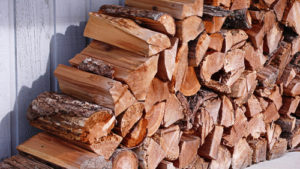How to Season and Store Firewood
At this time of year, it may be difficult to find firewood when you need it. Why? Because many suppliers have been selling out their supply for months and any wood you cut now will not be good for burning. In order for your fireplace, stove, or insert to work properly, you must burn only properly seasoned firewood. This means your wood should be cut many months before burning, and stored until winter.
Can You Burn Fresh Wood? 
Yes. You CAN burn freshly cut wood. If your family is freezing, and the only wood you have to burn is freshly cut, it will burn. It will be difficult to light, will not reach a high temperature, will burn incompletely, produce more smoke than heat, and will put more creosote in your chimney than necessary. To reach the desired temperature, a homeowner may use three times more wood than you would with properly seasoned firewood. This wastes fuel and damages your system.
Properly Seasoned Wood
Your firewood was once a live tree which stored and used water in order to live. When it’s cut, it likely has a water content higher than 75 percent. When you burn this “green” or “wet” wood, it has to first evaporate the water before burning the fuel (wood). Think about it like this: you’re camping in the rain and attempting to light a fire. Would you use wood that has been soaked with rainwater, or would you dig through brush and grasses to find dryer pieces? Firewood is the same. The best-burning wood is cut and allowed to dry for 3-6 months before being burned. This ensures a water content of less than 35 percent.
DIY Seasoned Firewood.
First, find a good supply of the type of tree you’d like to harvest. Harder species of wood burn differently than softer ones, but all will burn well when properly-seasoned.
Next, cut the tree down, and cut it to the desired length. Letting the wood sit like this will allow water to drain and evaporate from the ends faster than letting a felled tree dry. Letting the whole tree sit will likely result in a rotted tree, not seasoned firewood.
Finally, store the firewood until you need it. If you wait to split your firewood until it’s dry, it will be easier to split and lighter to carry.
Buying Firewood
It may be that you do not have a good source for firewood on your land. You can still have a wood fire by purchasing seasoned firewood from a local supplier. When searching for a supplier, look for wood that is cut and stacked in piles that look seasoned. It is seasoned firewood if it is gray in color, light in weight, has cracks along edges, and the bark pulls away from the flesh. Don’t pay too much for a cord or rank of wood. Make sure you understand what these terms mean, and how much you should be paying.
How to Store Your Supply
Whether you’re storing bought or self-cut wood, use an open pile, a tarp, or a shed. The only mistake you can make storing firewood is enclosing it tightly to prevent airflow. Air and light are necessary to season the firewood properly.
Hudson Chimney can help you determine if your fireplace problems are from improper wood. We may even be able to help you find a supplier. Contact Hudson Chimney today for help at 904-282-4159.
